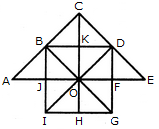Discussion
Home ‣ Non Verbal Reasoning ‣ Analytical Reasoning See What Others Are Saying!
- Question
Count the number of triangles and squares in the given figure.

Options- A. 26 triangles, 5 squares
- B. 28 triangles, 5 squares
- C. 26 triangles, 6 squares
- D. 28 triangles, 6 squares
- Correct Answer
- 28 triangles, 6 squares
ExplanationThe figure may be labelled as shown.
Triangles:
The simplest triangles are JBO, BKO, KDO, DFO, FGO, GHO, HIO, IJO, ABJ, BCK, CKD and DEF i.e.12 in number.
The triangles composed of two components each are IBO, BDO, DGO, GIO, ABO, CDO, CBO, CBD and DEO i.e. 9 in number.
The triangles composed of four components each are IBD, BDG, DGI, GIB, ACO and COE i.e. 6 in number.
There is only one. triangle i.e. ACE composed of eight components.
Thus, there are 12 + 9 + 6 + 1 = 28 triangles in the given figure.
Squares:
The squares composed of two components each are BKOJ, KDFO, OFGH and JOHI i.e. 4 in number.
There is only one square i.e. CDOB composed of four components.
There is only one square i.e. BDGI composed of eight components.
Thus, there are 4 + 1 + 1 = 6 squares in the given figure.
More questions
- 1. NA
Options- A. 1
- B. 2
- C. 3
- D. 4 Discuss
Correct Answer: 3
Explanation:
NA
- 2. NA
Options- A. 1
- B. 2
- C. 3
- D. 4 Discuss
Correct Answer: 4
Explanation:
NA
- 3. NA
Options- A. 1
- B. 2
- C. 3
- D. 4 Discuss
Correct Answer: 4
Explanation:
NA
- 4. NA
Options- A. 1
- B. 2
- C. 3
- D. 4 Discuss
Correct Answer: 4
Explanation:
NA
- 5. Find the question mark
? figure from answer figure:

Options- A. 1
- B. 2
- C. 3
- D. 4 Discuss
Correct Answer: 3
Explanation:
The second figure is the mirror image of the first figure.
- 6. Choose the figure which is different from the rest.
 (1) (2) (3) (4) (5)
(1) (2) (3) (4) (5)
Options- A. 1
- B. 2
- C. 3
- D. 4
- E. 5 Discuss
Correct Answer: 2
Explanation:
In all other figures, both the arrowheads lie towards the diameter of the semicircle.- 7. NA
Options- A. 1
- B. 2
- C. 3
- D. 4 Discuss
Correct Answer: 4
Explanation:
NA
- 8. 108460
Options- A. 1
- B. 2
- C. 3
- D. 4 Discuss
Correct Answer: 1
Explanation:
In all other figures, the design has been divided into four parts. But all three figures are different to figure ( 1 ) .
- 9. Pankaj is taller than Vinod, who is shorter than Pramod. Usha is taller then priyanka but shorter than Vinod. Pramod is shorter than Pankaj. Who is the tallest?
Options- A. Priyanka
- B. Pramod
- C. Vinod
- D. Pankaj Discuss
Correct Answer: Pankaj
Explanation:
- 10. NA
Options- A. 1
- B. 2
- C. 3
- D. 4 Discuss
Correct Answer: 2
Explanation:
NA
Comments
There are no comments.
- 1.
Programming
Copyright ©CuriousTab. All rights reserved.
